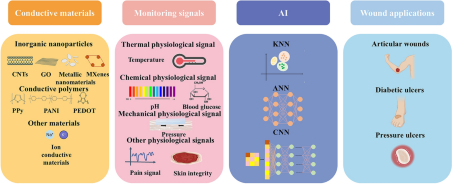Artificial Intelligence‑Assisted Conductive Hydrogel Dressings for Refractory Wounds Monitoring
Published in Materials and Computational Sciences

As chronic wounds such as diabetic ulcers, pressure ulcers, and articular wounds continue to challenge global healthcare systems, a team of researchers from China has introduced a promising innovation: AI-integrated conductive hydrogel dressings for intelligent wound monitoring and healing.
This comprehensive review, led by researchers from China Medical University and Northeastern University, outlines how these smart dressings combine real-time physiological signal detection with artificial intelligence, offering a new paradigm in personalized wound care.
Why It Matters:
- Real-Time Monitoring: Conductive hydrogels can track key wound parameters such as temperature, pH, glucose levels, pressure, and even pain signals—providing continuous, non-invasive insights into wound status.
- AI-Driven Analysis: Machine learning algorithms (e.g., CNN, KNN, ANN) process sensor data to predict healing stages, detect infections early, and guide treatment decisions with high accuracy (up to 96%).
- Multifunctional Integration: These dressings not only monitor but also actively promote healing through electroactivity, antibacterial properties, and drug release capabilities.
Key Features:
- Material Innovation: The review discusses various conductive materials (e.g., CNTs, graphene, MXenes, conductive polymers) and their roles in enhancing biocompatibility, sensitivity, and stability.
- Smart Signal Output: Different sensing mechanisms—such as colorimetry, resistance variation, and infrared imaging—enable multimodal monitoring tailored to wound types.
- Clinical Applications: The paper highlights applications in pressure ulcers, diabetic foot ulcers, and joint wounds, emphasizing the potential for home care, remote monitoring, and early intervention.
Challenges & Future Outlook:
Despite promising advances, issues such as material degradation, signal stability, and AI model generalizability remain. Future efforts will focus on multidimensional signal fusion, algorithm optimization, and clinical translation to bring these intelligent dressings into mainstream healthcare.
This work paves the way for next-generation wound care, where smart materials meet smart algorithms—offering hope for millions suffering from chronic wounds.
Stay tuned for more innovations at the intersection of biomaterials, AI, and personalized medicine!
Follow the Topic
-
Nano-Micro Letters

Nano-Micro Letters is a peer-reviewed, international, interdisciplinary and open-access journal that focus on science, experiments, engineering, technologies and applications of nano- or microscale structure and system in physics, chemistry, biology, material science, and pharmacy.






Please sign in or register for FREE
If you are a registered user on Research Communities by Springer Nature, please sign in